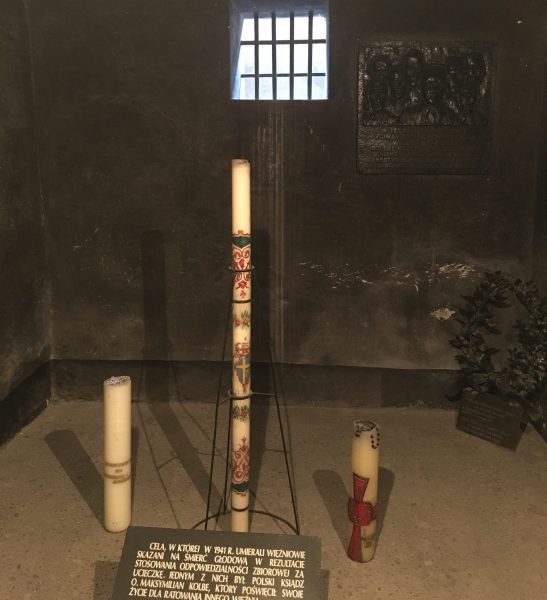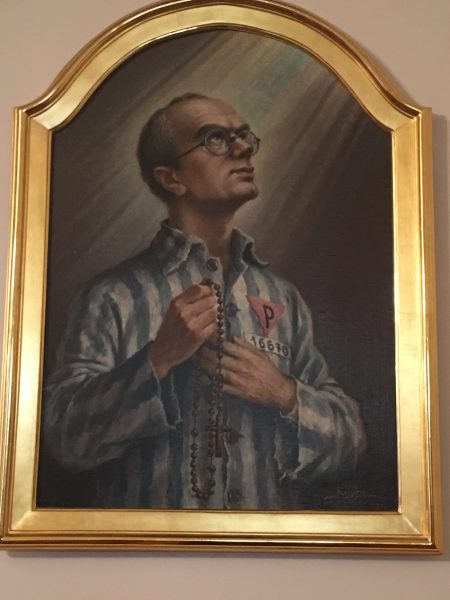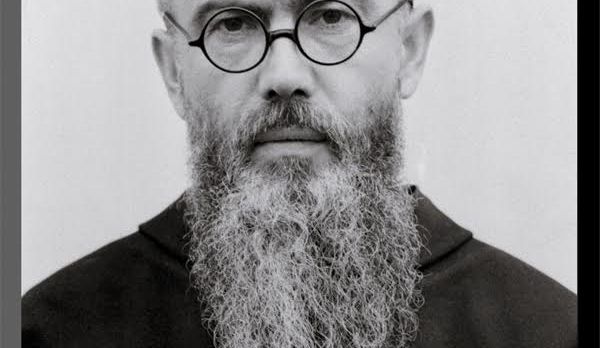We were graced this month to travel to Poland on a parish pilgrimage. It was my first extended visit to the country, so it was therefore a great joy to visit Niepokalanow — the friary of St. Maximilian Kolbe. The visit started with Mass in the simple chapel founded by the saint. We continued by visiting his cell, viewing his relics and then worshipping in the modern basilica that stands on the site.
The next day our pilgrims visited the great Marian shrine of Czestochowa before going on to Auschwitz. The amazing accomplishments of St. Maximilian Kolbe climaxed in his death at the extermination camp, and to visit his monastic cell one day and his death cell the next was an awesome, moving and troubling experience. Here was a man, who, from his early life, decided to live for others and ended his life dying for another.
Raymund Kolbe was born on January 8, 1894, in Zduńska Wola, Poland. In 1907 Kolbe and his brother Francis left to join the Franciscans. Three years later he became a Franciscan novice, taking the name Maximillian.
A brilliant student, Kolbe earned a doctorate in philosophy in 1915, then continued his studies at the Pontifical University of St. Bonaventure where he earned a doctorate in theology. In 1918, he was ordained a priest and returned to the newly independent Poland, where he was active in promoting the veneration of the Immaculate Virgin Mary. From 1919 to 1922 he taught at the Kraków seminary. In January 1922 he founded the monthly periodical named Knight of the Immaculate, and over the next few years his publishing endeavors grew amazingly. Young men flocked to join him, and In 1927 he founded a new Franciscan monastery at Niepokalanów near Warsaw, which boasted almost 800 young friars and became a huge religious publishing center. To cope with the army of men wanting to serve Jesus and Mary, Kolbe founded a junior seminary was opened there two years later.
If that wasn’t enough, between 1930 and 1936, Kolbe undertook a series of missions to the Far East, at first in China, and then in Japan and Malabar in India. With only one lung from a bout with tuberculosis, living in abject poverty and working tirelessly, Kolbe’s health was failing. Back at Niepokalanów he started a radio station and became increasingly involved in giving a Catholic response to the growing troubles with Germany. Then in 1939, after the German invasion of Poland, Kolbe’s troubles with the Nazis began.
He and his brothers hid Jews at Niepokalanów and eventually the Nazis arrested Kolbe and shipped him to Auschwitz, where he died by injection of carbolic acid after being starved for two weeks. The Franciscan friar had stepped forward to offer his life for that of another prisoner, who had pleaded for his life because he had a wife and children.
The experience of visiting Auschwitz will make anyone reel in gut-wrenching horror. The crowds of tourists are rightly solemn and silent as they make their way through the world’s greatest museum of humanity’s inhumanity. We pilgrims found our minds and our stomachs churning. It is impossible to take it in, and quickly process the truths you are learning.
Like most, I had to ask where God was in the midst of such horror.
The turning point was our visit to the cell where Kolbe was martyred. You wend your way down into the cellar of the prison block, and there in one darkened cell is a barred window, out of which only the sky can be seen. On the floor are three candles. They provide the answer.

Where was God in Auschwitz? He was there in the prison cell, just as he was at the crucifixion of Christ, not defeating the evil with violence or force but by embracing the evil as the sacrificial victim. Whenever and wherever possible we must do all we can to oppose evil by passive resistance, civil disobedience, protest, boycott and even armed force, but when the evil is so overwhelming, when the stench of hell is so great and the hatred of Satan so violent as that of Auschwitz, one can only stand back, aghast and horrified by the hurricane of sheer, unadulterated cruelty, torture and premeditated murder.
Then all resistance is futile. Then any response — even one of charity and forgiveness — will be met with spitting fury. Then is the time for the silence of the lambs. Then all the Christian soul can do is to accept the role of victim and nobly embrace to the martyr’s death. Kolbe’s death as a sacrificial victim somehow turned the tables as the death of every martyr turns the tables, and shows even at the moment of death that violence can never win. As the darkness can never overcome even the smallest light, so the hatred of hell can never overcome the love of heaven.
In the center of Kolbe’s cell deep in the cellar of the punishment block the candles are a sign for they are Paschal candles. They stand like the three crosses on the hill — like three sentinels they stand alone in the unrelenting gloom of the harsh concrete room. Presented by two popes and a cardinal, the Paschal candles are solemn reminders that even in the darkest place there is hope, and that even in the depths of the extermination camps the life and light of Easter conquers all.

Fr. Dwight Longeneckeris a former Evangelical, then an Anglican priest and now a Catholic priest. Visit his website atdwightlongenecker.comto browse his books and be in touch.

